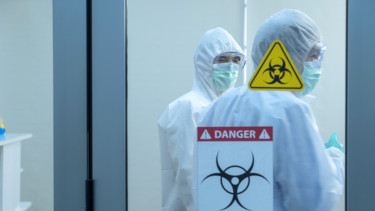Hungary sets new flu record

Key findings:
- Almost 39% of the samples tested on the 8th week of 2025 showed infection with some kind of influenza virus; down from over 52% a week earlier;
- the influenza positivity rate for all samples tested (26.4%) continues to exceed the falling cumulated Covid positivity rate (8.1%), while the flu rate never took the lead in the 2023/24 season;
- the coronavirus positivity rate was down at 0.6% from 1.0%, while
- the RSV positivity rate rose further to 5.6% from 5.0%;
- the number of human metapneumovirus (HMPV) infections reached 70 or 1.1% of all samples tested, which figures compare with 50 and 1.0% a year earlier;
- the number of people hospitalised with severe acute respiratory infection (SARI) rose to 308 from 290, which is lower the comparative figures in the 2023/24 (357) and 2022/23 (315) respiratory seasons;
- 1.6% of those hospitalised tested positive for COVID-19, while there were 119 people with influenza infection in hospital, which corresponds to 38.6& of all SARI patients; and 47 people were treated in hospital with RSV infection (15.3% of all SARI patients);
- of the 308 people in hospital with SARI, 113 (36.7%) were aged two years or younger, up from the 7th week (81 or 27.9%), while 89 (28.9%) were aged 60 years and older, down from 103 or 35.5% on the previous week.
Optimism proved to be premature, situation worsens further
With fewer Hungarians going to the doctor with respiratory infections, and in light of the epidemiological pattern of previous respiratory seasons, we said two weeks ago that the peak might have been reached. We were wrong, as data showed already last week and confirmed this week.
On the 8th week of 2025 (17-23 February), 329,400 people sought medical help with acute respiratory infections (ARI), including 89,400 people with influenza-like illness (ILI), according to data released by the National Centre for Public Health and Pharmacy (NNGYK) on Thursday. The ARI figure rose by 5.4% w/w and the ILI by 3.0%, following increases of 1.7% and 5.7% respectively in the 7th week.
The respiratory season (often and erroneously referred to as 'flu season') generally peaks between the 4th and the 9th week of the year.
A short-term comparison (for the last three seasons of respiratory illnesses) shows that the number of patients with ARI, including those with ILI was much higher than at this point in the previous two respiratory seasons.

The share of influenza-like illness in ARI was down at 27.1% from 27.8% on the 7th week, exceeding the comparative readings from the past two seasons (19.3% and 22.1%, respectively), meaning that effectively more than a quarter of ARI patients showed symptoms of influenza.

We also have data for ARIs and flu-like symptoms per 100,000 inhabitants, although a long-term data series is available only for the latter.
in terms ari is worse and in terms of people with Influenza-like illness per 100,000 people, the situation is currently way worse than in either of the previous two respiratory seasons.


In the graph below you can compare to the flu situation with the previous 13 respiratory seasons, and find that the situation has not been this worse in that period.

The NNGYK reassured us in response to our enquiries three weeks ago that they "keep a close eye on the rate of serious illness", and draw the conclusion that with 0.09% of all patients requiring hospitalisation, "the virus currently circulating is not causing more severe illness than we are used to."
On the 8th week, the ratio edged further up to 0.094%, but it remains lower than either one or two years ago.

Positivity rates
A total of 498 samples were tested on the 8th week, down from the record of 515 samples on the 6th week, with only 3 coming back COVID-19 positive. The 0.6% positivity rate compares with 2.3% (8 cases) a year ago and 5.2% (8 cases) two years ago.

The share of influenza (38.8%) in the tested samples is slightly above the previous year's reading (36.9%), but much lower than two years ago (60.1%), while that of respiratory syncytial virus (RSV) remains lower at 5.6% than in 2023/24 (11.6%) and 2022/23 (7.2%).


The following graph may seem a bit fuzzy at first but at least it shows a side-by side comparison of the weekly positivity rates for influenza (green), Covid (orange), and RSV (blue) for the past three respiratory seasons up to the 8th week. It is evident how the flu positivity rate stood out this year, up to the 8th week that is, whether we compare it to the corresponding rates in the previous two years or to the Covid and RSV positivity rates.

As regards the individual positivity rates in all the samples, the 'switch' never took place in the 2023/24 respiratory season (i.e. the total number of positive Covid tests in all samples tested remained higher than the number of positive flu tests) in and occurred by the end of the 3rd week in the 2022/23 season.
As the chart below attests, SARS-CoV-2 is no longer the main pathogen in samples, with 520 positive tests (8.1% of the 6,420 samples tested), as influenza has been in the lead (since the 4th week) with 1,693 positive samples by week 8 (26.4% of all samples), followed by RSV (137), human metapneumovirus (HMPV, 70), rhinovirus (53), parainfluenza (6), adenovirus (5), and bocavirus (4).

Hospitalisations
308 people with severe acute respiratory infection (SARI) were hospitalised on the 8th week of 2025, of whom 32 (or 10.4%) required intensive care. On the 8th week in the previous two respiratory seasons 11.8% and 13.7% of SARI patients were treated in ICUs, respectively.

Further breakdown shows that 5 people (1.6% of SARI patients) were hospitalised with SARS-CoV-2 infection, way fewer than either a year ago (27, 7.6%) or two years ago (59, 18.6%).

A total of 119 people in hospital with SARI tested positive for influenza, which corresponds to 38.6% of all SARI patients.
This compares with 82 influenza patients (23% of all SARI patients) in hospital on the 8th week of 2024 and 70 (22.2%) on the same week of 2023.

The share of RSV patients rose to 15.3% (47) from 14.1% (41), which compares with 28% (100) a year earlier and 13.7% (43) two years earlier.

Age distribution of hospitalised SARI patients
Of the 308 people in hospital with SARI, 113 (36.7%) were aged two years or younger, which shows an increase from 91 (27.9%) a week earlier, while 89 (28.9%) were aged 60 years and older, a sharp drop from the 7th week (103, 35.5%).

40% of the five COVID-19 patients were over 60 years of age. A year ago, of the 257 people in hospital with SARI, 154 (43.1%) were aged two or younger, while 102 (28.6%) were 60 or older. Also, 20 or about three quarters of the 27 COVID-19 patients were over 60 years of age.

The age breakdown of people seeking medical help with ARI and flu-like symptoms are shown below.
The majority of ARI patients belonged in the 0-14 age group throughout the 'flu season' last year (and so far this year too), while the share of people going to the doctor with flu-like symptoms was the highest in the 15-34 age group up to the 2nd week of last year when the youngest were in majority for nine weeks and then it was back and forth between the 13th and 20th week. You fund a heat map for the previous season in one of our previous articles here.
The number and share of children up to 14 years of age remains higher among people with influenza-like illness than the number and share of those in the 15-34 age group, for the sixth week in a row, after a brief switch on the first two weeks of 2025.
some 155,000 of people with ARI and almost 40,000 of people with ILI were in the 0-14 age group on the 8th week of 2025. The former compares with about 144,700 a year earlier, while the latter compares with almost 22,200 in the base period.


Whooping cough stays with us too
The number of suspected pertussis cases does not seem to be dropping, either. Based on the figures for the first seven weeks of the year, it looks likely that 2025 will bring another record, unless a dramatic improvement occurs along the way.
The number of suspected whooping cough cases closed at an absolute record of 1,354 cases in 2024. Authorities reported 14 suspected cases for the 7th week of 2025, by which time over 34,3% of the 99 cases were infants this year. Also, about 47.5% of the infections were detected in the 0-14 age group and 53.5% in the 0-19 age group.





Cover image (for illustration purposes only): Getty Images






